The Submerged Sensors of Sebago Lake
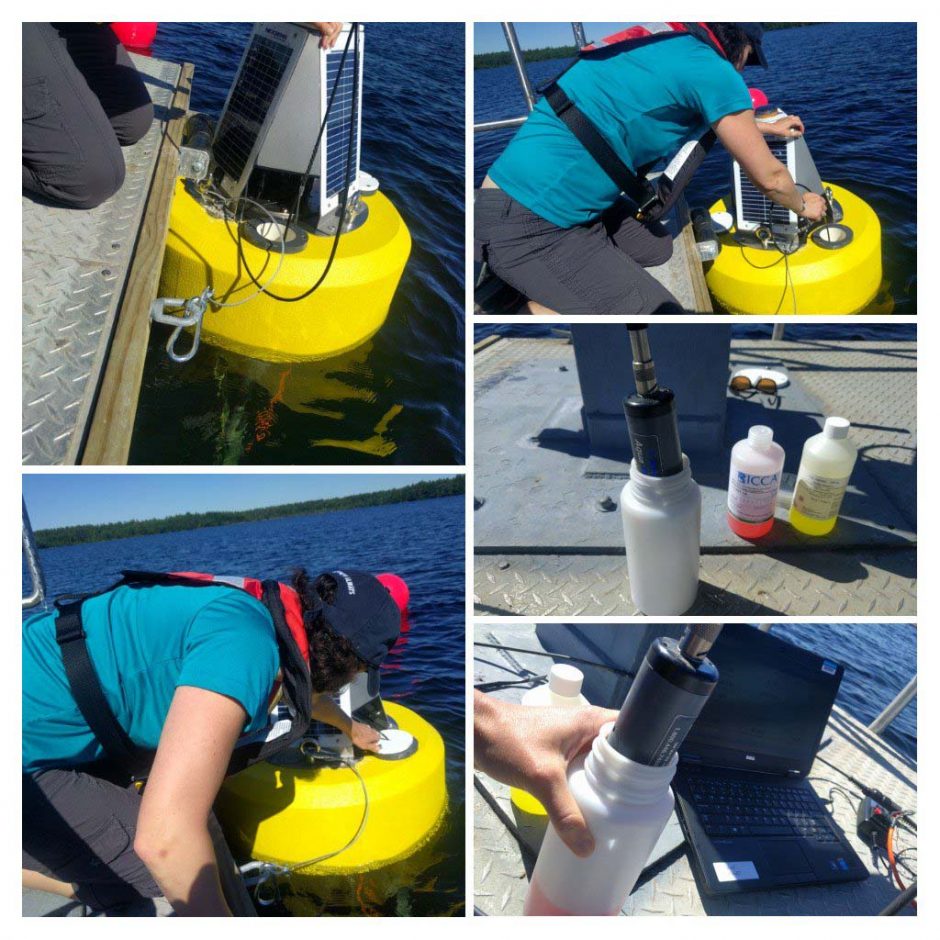
Calibrating the AquaTroll. (Credit: PWD, via communication)
This summer, a joint project between the Portland Water District (PWD) and Saint Joseph’s College of Maine (SJC) submerged around 145 pounds of new, high-tech equipment in Sebago Lake. The new equipment includes a data buoy and sensors that monitor water quality parameters in the lake in real time, updating data every 15 minutes.
Sebago Lake is the second largest lake in Maine, and among the country’s only lakes with clean enough water for use by a drinking water facility without filtration requirements—with residents of the Greater Portland area as the beneficiaries.
Brie Holme, a water resources specialist with PWD, and Dr. Emily Lesher, an assistant professor at SJC, discussed the collaboration and the new tech with EM.
Monitoring Sebago Lake
Although the waters of Sebago Lake have always been very clear, this monitoring project is a proactive attempt to prevent some of the problems that predicted changes might cause.
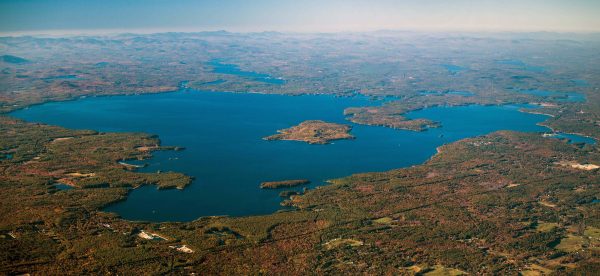
Sebago Lake, aerial view. (Credit: Mark Hunt, via communication with PWD)
“Maine has some of the cleanest lakes in the country, and Sebago is one of the cleanest in Maine,” explains Holme. “Fifteen percent of Maine’s population is fortunate to have Sebago Lake as their drinking water supply. However, New England’s lakes are changing in response to climate, use, and development stressors. Winter ice is forming later and melting earlier, giving algae an extended growing season. And increased rainfall and more frequent extreme storms mean more phosphorus and organic carbon-rich sediments wash into our lakes where they feed algae. These and other changes make it important to keep an even closer eye on the water supply.”
The Lakes Environmental Association also already deploys two similar buoys: one on Long Lake and one on Highland Lake in Bridgton. The PWD has been monitoring the lake monthly from May through October for decades, but now, thanks to the new buoy, they will be getting data from the Lower Bay’s deepest point every 15 minutes.
The new monitoring approach is part of an investment in healthy water in the lake and the region—a commitment shared by SJC and PWD.
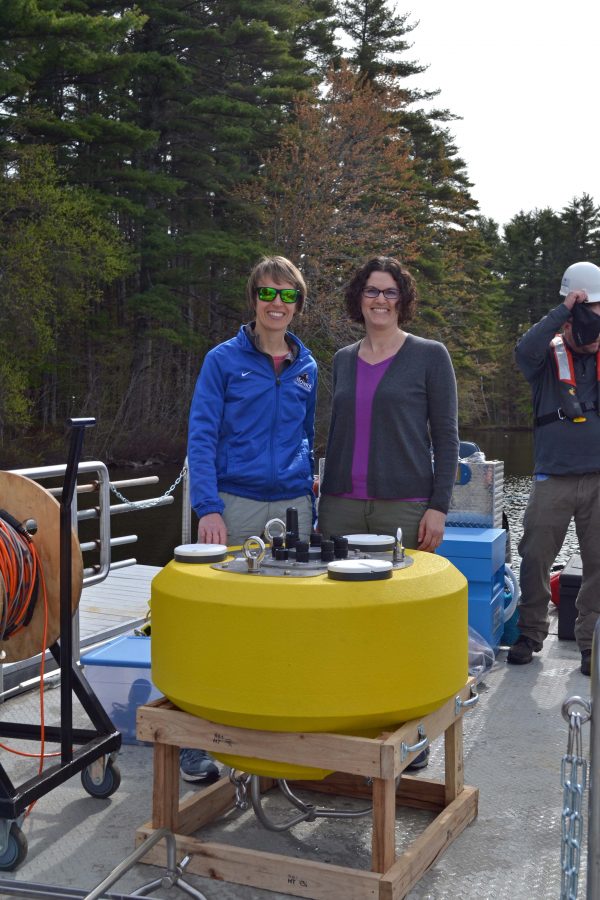
Dr. Lesher and Holme on deployment day.(Credit: PWD, via communication)
“PWD is invested in the long-term health of Sebago Lake for clear reasons: it is one of the very few water utilities in the country that is exempt from filtration requirements,” remarks Dr. Lesher. “That is only possible because the water is so clean and clear. Changing the treatment scheme would be costly to ratepayers and be more energy intensive.”
Dr. Lesher’s college is also committed, at an ideological level.
“At SJC, a Sisters of Mercy institution, sustaining the environment is directly in keeping with our College’s mission statement, strategic plan, and our core values,” adds Dr. Lesher. “Specifically, the mission calls for ‘advocate for justice and peace in recognition of each person’s responsibility for the welfare of both humankind and the environment.’ Being able to monitor the health of the lake in the face of climate change and development within the watershed is the first step toward a sustainable future.”
The new monitoring buoy’s sensor array monitors and transmits data on the lake’s chlorophyll, clarity, dissolved oxygen, pH, and temperature. The data is available here, updated every 15 minutes, while the buoy is deployed. Brie Holme describes the buoy’s technical specifications:
“The Sebago Lake buoy is a NexSens CB-450 data buoy from Fondriest Environmental and has the following sensors: an AquaTroll 400 multi-parameter probe that we use to measure temperature, dissolved oxygen, and PH at a depth of 2 meters; a NexSens TS210 Thermistor String which has 14 temperature sensors throughout the water column; two Turner Designs Cyclops -7F Submersible Sensors for measuring chlorophyll at depths of 6 and 10 meters; an In-Situ RDO PRO-X Optical Dissolved Oxygen Sensor at a depth of 38 meters, just above the bottom of the lake; and two LI-COR LI-192 Underwater PAR Sensors at depths of 1 and 6 meters for measuring water clarity,” comments Holme.
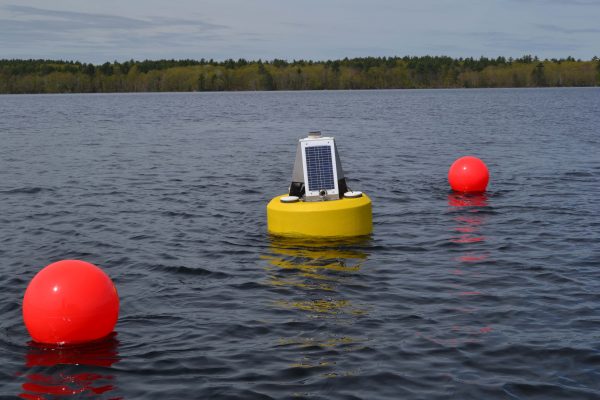
The buoy deployed on the lake. (Credit: PWD, via communication)
Importance of real-time data
In the past, the PWD has sampled from Sebago Lake monthly. However, having data come every 15 minutes will provide many new opportunities for both the water district and the community.
“We are also able to better see time-based trends in the data,” states Dr. Lesher. “We knew that dissolved oxygen tends to decrease in the depths of the lake over the summer as organic matter decomposes—a process that requires oxygen—but we are learning more about that process as we observe the rates and nature of the changes.”
Having more frequent data can also help the experts understand how weather affects the lake—and the drinking water that comes from it.
“Last October near Halloween we had some severe storms and even some tornadoes here in western Maine,” remarks Holme. “The real-time temperature data that our buoy collected allowed us to see exactly when the lake turned over and it was clear that turnover was initiated by the storm.”
The buoy data can help researchers and officials “see” how storms disturb the layers of water in the lake and cause them to mix. This seasonal process, sometimes called “flipping,” in turn redistributes nutrients in the water. It is therefore very important that the PWD be able to visualize this kind of flipping as it is taking place.
“At the Portland Water District’s Sebago Lake Water Treatment Facility, lake turnover and its associated increase in raw water turbidity require a change in the chemicals that are added to drinking water,” explains Holme. “The buoy’s real-time temperature data will be used by the District’s water operations staff to determine when lake turnover is happening.”
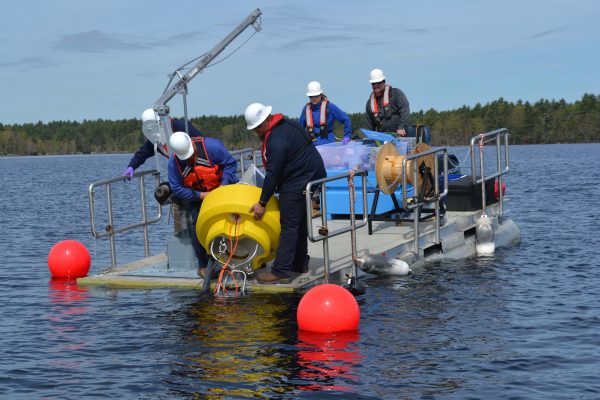
The team deploys the buoy. (Credit: PWD, via communication)
Of course, there are also other uses for the data.
“Meteorologists at NOAA’s weather forecasting office in Gray, ME are using the buoy’s water temperature data in their weather forecasting models,” comments Holme.
Educators will also be putting the data to work.
“With assistance from Windham High School science teacher Jeff Riddle and Sarah Plummer—the environmental education coordinator with PWD—we are developing a 3 to 4-week unit entitled ‘Discovering Lakes’ that Jeff will test-run in his 9th grade Earth Systems Science classroom this fall,” details Dr. Lesher. “The unit is rooted in the Next Generation Science standards and uses real data from the buoy, hones the skills that scientists use, and hopefully will capture the interest of young students who might enjoy fishing, swimming, and boating in Maine’s lakes. Alyssa Charette, 3rd-year biology and secondary education major from SJC, is the lead on this project. It will be available to the public.”
Dr. Lesher and others will use the buoy’s data at the college level as well.
“At SJC, I will use the buoy data in my Principles of Chemistry and Environmental Chemistry classes,” she remarks. “Lakes are excellent examples of complex systems—much more complex than your lab test tube. The dissolved oxygen data can illustrate things like Henry’s law, and then be related to more complex topics like how redox chemistry and sediment-water interactions.”
Healthy buoy, healthy lake
The buoy itself was customized for the project by Fondriest Environmental. It’s almost entirely solar powered and works even in bad weather. “The buoy hasn’t lost power yet!” states Holme.
Although the sensors can last for years at a time, the buoy must be calibrated monthly. However, those monthly calibrations can take place on the water—thanks to some custom-made equipment.
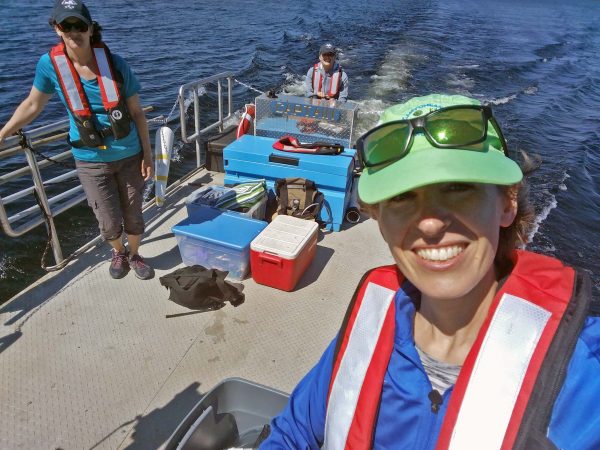
Dr. Lesher, Holme, and another team member on calibration day. (Credit: PWD, via communication)
“The buoy is located in the no bodily contact zone of the lake where no one is allowed to touch the water,” Holme describes. “We worked with Fondriest to come up with a way to retrieve the AquaTroll Multiparameter Probe for calibration without putting our hands in the water. This involved attaching a 4-inch schedule 80 PVC deployment pipe to the buoy. The AquaTroll hangs inside the pipe, which we perforated, and in this way can be retrieved from the top of the buoy instead of from under the water.”
Of course, there will still be some trial and error as the team works with the buoy and sensors in the coming year.
“The bottom DO sensor is much less susceptible to biofouling at a depth of 38 meters, and we’re still figuring out how often it will need to be calibrated, with this being our first full season with the buoy,” adds Holme.
Although the PWD and SJC have plans in place for the buoy at this point, they’re also keeping their options open, and gathering information to shape their long-term vision for this project.
“In February, Saint Joseph’s College and Portland Water District will be hosting a ‘State of the Lake Symposium’ for Sebago Lake users, lake researchers, educators, and area residents,” remarks Holme. “At this event, we want to engage the public (fishermen, homeowners, etc.) in a dialogue about how they want to access and use lake data, what issues about the lake they are they concerned about, and what about the lake have they noticed changing over the years. We plan to use this information to guide our future outreach and education efforts.”
In the meantime, learn more about the project online:
“The Sebago Lake buoy data is available at PWD.org and on your phone via the mobile app ‘LIVE Datacenter,’” states Holme. “Follow us on Twitter: @SebagoLakeBuoy.”
Top image: Calibrating the AquaTroll. (Credit: PWD, via communication)




0 comments